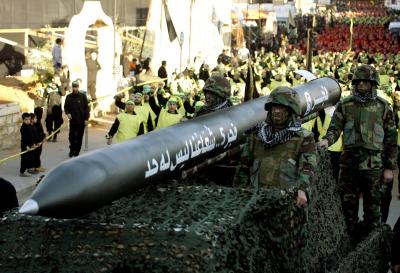Two sources familiar with Hezbollah's arsenal state that the powerful Russian anti-ship missiles acquired by the Lebanese group provide it with a means to execute the veiled threat made by its leader against US warships, highlighting the severe risks of any conflict in the region. Last week, Hezbollah Secretary-General Hassan Nasrallah warned Washington that his group has something in store for US vessels deployed in the region since the outbreak of the war last month between Hamas and Israel, which is dramatically shaking the wider Middle East.
The two informed sources in Lebanon indicated that Nasrallah was referencing the significantly enhanced anti-ship missile capabilities of the group, which include the Yakhont missile with a range of up to 300 kilometers. Media reports and analysts have suggested for years that Hezbollah, backed by Iran, obtained Yakhont missiles in Syria after deploying its fighters there over a decade ago to assist President Bashar al-Assad in the civil war.
A video has circulated in recent days showing anti-ship missiles reportedly in the group's possession, although Hezbollah itself has never confirmed owning this weapon. Washington states that its deployment in the Mediterranean, which includes aircraft carriers and supporting ships, aims to prevent the escalation of the conflict by deterring Iran, which supports groups such as Hezbollah, Hamas, and Palestinian Islamic Jihad.
Hezbollah views US warships as a direct threat due to their capability to strike the group and its allies. In a speech last Friday, Nasrallah declared that US warships in the Mediterranean “don’t scare us and have never scared us.” He added, “Your fleets that you threaten us with, we have also prepared for them.”
In response to Nasrallah’s speech, the White House stated that Hezbollah should not exploit the war between Hamas and Israel, emphasizing that the US does not want the conflict to spread to Lebanon. One source indicated that Hezbollah's anti-ship capabilities have significantly evolved since 2006 when the group first demonstrated its ability to hit a ship at sea by striking an Israeli warship during its conflict with Israel.
The source commented that Hezbollah utilizing this weapon to target enemy warships would signal a transformation of the conflict into a major war in the region. "We are paying close attention," said three current and one former US official, noting that Hezbollah has built an impressive arsenal including anti-ship missiles. One official remarked, "It is clear that we are taking this seriously," without directly commenting on whether the group possesses the Yakhont missile.
The US officials indicated that the naval force recently deployed in the region includes defenses against incoming missiles but did not provide further details. The US Department of Defense has deployed warships in the eastern Mediterranean since October 7, when Hamas militants attacked Israel from the Gaza Strip in an assault that Israel claims resulted in 1,400 deaths. Palestinian officials state that Israeli attacks on Gaza since then have killed over 10,000 Palestinians.
Nasrallah warned Washington on Friday that avoiding war in the region depends on halting the Israeli assault. Since October 8, Hezbollah and Israeli forces have exchanged fire along the Lebanese border, representing the most severe escalation there since the 2006 war. However, Hezbollah has only utilized a small portion of its arsenal so far, and exchange violence has largely been confined to the border area.
Other Iran-allied groups, such as the Houthis in Yemen, have launched drones toward Israel, while Iranian-backed Shia factions have also attacked US forces in Iraq and Syria. According to a report by the Center for Strategic and International Studies based in Washington, the Yakhont missile flies at a low altitude of between 10 and 16 meters, making it difficult to detect.
The report indicates that the Yakhont missile, a variant of the P-800 Oniks, was developed in 1999 for export by a Russian defense company and can be launched from air, land, or submarines. In response to inquiries about reports of Hezbollah acquiring Yakhont missiles, Kremlin spokesperson Dmitry Peskov stated, "First and foremost, this is completely unconfirmed news; we do not know if it is true or not." He added, "Secondly, we do not have such information." The Russian Ministry of Defense did not respond to a written request for comment, and the Syrian Ministry of Information has not yet responded to Reuters’ email inquiries.
Nasrallah's speech on Friday represented one of his strongest warnings yet to the US, which holds his group responsible for the suicide bombing that destroyed the US Marine barracks in Beirut in 1983, killing 241 servicemen, as well as a suicide attack on the US embassy the same year that killed 63 people. He described the missile as "the most important prize" for Hezbollah's intervention in the Syrian war, where the group helped shift the dynamics of the civil war in favor of Assad.
One source noted, “Yes, Hezbollah has prepared and is ready.” The two sources who spoke with Reuters in Lebanon indicated that Hezbollah acquired this weapon from Syria while fighting in support of Assad, whose army has long been armed by Russia. The details surrounding Hezbollah’s arsenal and how it is obtained are shrouded in secrecy. In rare comments about them in 2021, Nasrallah explained how the group obtained Russian-made Kornet anti-tank missiles through Syria.
In an interview with the Iranian-allied Lebanese channel Al-Mayadeen, Nasrallah stated that the Syrian Ministry of Defense purchased the weapons from Russia for use in Syria, and Hezbollah later took them as a form of "support" to defend Lebanon. He added, "As a resistance, we took them to defend our country and used them in the July war. We took them as support." Hezbollah extensively used this weapon in the 2006 war. Moscow stated in 2010 that it had signed an agreement to send anti-ship cruise missiles, including a variant of the Yakhont missile, to Damascus.




